Researchers have potentially found a Neptune-sized exomoon orbiting a Jupiter-sized planet in a system with a Sun-like star, making it the second such potential exomoon discovered to date. Plus, rocket launches, This Week in Rocket History, and What’s Up.
Podcast
Show Notes
SpaceX rocket launches 105 satellites
- Transporter-3 Mission page (SpaceX via archive.today)
- Nanoracks press release
- Launch video
Launcher One sends seven satellites into orbit
- Above the Clouds mission page (Virgin Orbit)
- Launch video
Insight faces dust storm
- NASA JPL press release
Found: One squished planet
- ESA press release
- “Detection of the tidal deformation of WASP-103b at 3 σ with CHEOPS,” S. C. C. Barros et al., 2022 January 11, Astronomy & Astrophysics
New moon found orbiting alien world
- Astronomers Have Found Another Possible ‘Exomoon’ beyond Our Solar System (Scientific American)
- “An exomoon survey of 70 cool giant exoplanets and the new candidate Kepler-1708 b-i,” David Kipping et al., 2022 January 13, Nature Astronomy
Stars lock away heavy metals in white dwarfs
- Science in Public press release
- “The most metal-rich asymptotic giant branch stars,” Amanda I Karakas, Giulia Cinquegrana, and Meridith Joyce, 2021 November 9, Monthly Notices of the Royal Astronomical Society
What’s Up: The JWST can be seen in a telescope
- Where is Webb (NASA)
- About the Sunshield (NASA)
- Will the James Webb Space Telescope be visible from earth? (Stack Exchange)
This Week in Rocket History: ISRO’s SRE-1 capsule
- Space Capsule Successfully Recovered (ISRO)
- PDF: Space Capsule Recovery Experiment slide presentation (APRSAF via Internet Archive)
- PDF: Report no. 306 (Parliament of India)
- Soyuz T-11 info page (Space Facts)
Transcript
Hello and welcome to the Daily Space. I am your host Dr. Pamela Gay.
And I am your host Erik Madaus.
And we are here to put science in your brain. And some rockets. Today’s episode actually starts out with some rockets.
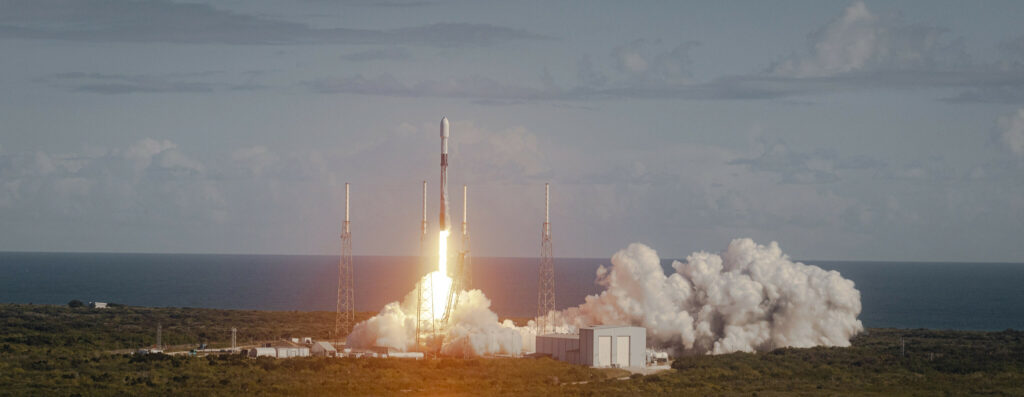
On January 13 at 15:25 UTC, a SpaceX Falcon 9 launched the Transporter-3 mission into polar orbit from SLC-40 at the Cape Canaveral Space Force Station in Florida. Like SpaceX’s previous Transporter rideshare missions, Transporter-3 carried 105 CubeSats, smallsats, and orbital tugs to orbit.
Most of the time, Falcon 9 first stages land on an Autonomous Spaceport Drone Ship offshore in the Atlantic. Although there were a lot of CubeSats on this mission, they didn’t weigh that much – a few metric tons at most – so SpaceX was able to do a full Return To Launch Site. The RTLS trajectory is preferable as it puts the least amount of stress on the booster’s structure through reentry and landing, but it’s not usually possible because it significantly reduces the amount of payload the rocket can put into orbit.
Speaking of the booster, it was 1058 on its tenth flight, the third Falcon 9 first stage to meet this milestone after boosters 1049 and 1051. Together, these three boosters are responsible for 22% of all Falcon 9 launches.
We don’t have time to go into detail on many of the payloads. I am gonna talk about one of them because it’s really cool: it isn’t a satellite.
The Mars Outpost Demo will demonstrate cutting a piece of 316 stainless steel with the goal of “exploring the feasibility of reusing abandoned space vehicles”. The payload consists of a robot arm with a cutting wheel, three stainless steel samples, and a video camera to record the cutting. Maxar manufactured the robotic arm with the cutting wheel for Nanoracks, who is in charge of the overall payload. The arm will make its cuts without adding any additional orbital debris, according to Nanoracks. Structural cutting of this type has never been done in space before. The Demo will remain attached to the payload adapter on the Falcon 9’s second stage and be destroyed when it reenters over the South Pacific following a deorbit burn, for a total lifespan of about an hour.
The experiment only has two windows to downlink data from the experiment, one over McMurdo Station in Antarctica, and the other over the continental U.S., where it will have five ground stations to downlink the data to. This will maximize the chances of returning data from the experiment.
From a rocket that launched from the ground, our next story is one that launched from the air.
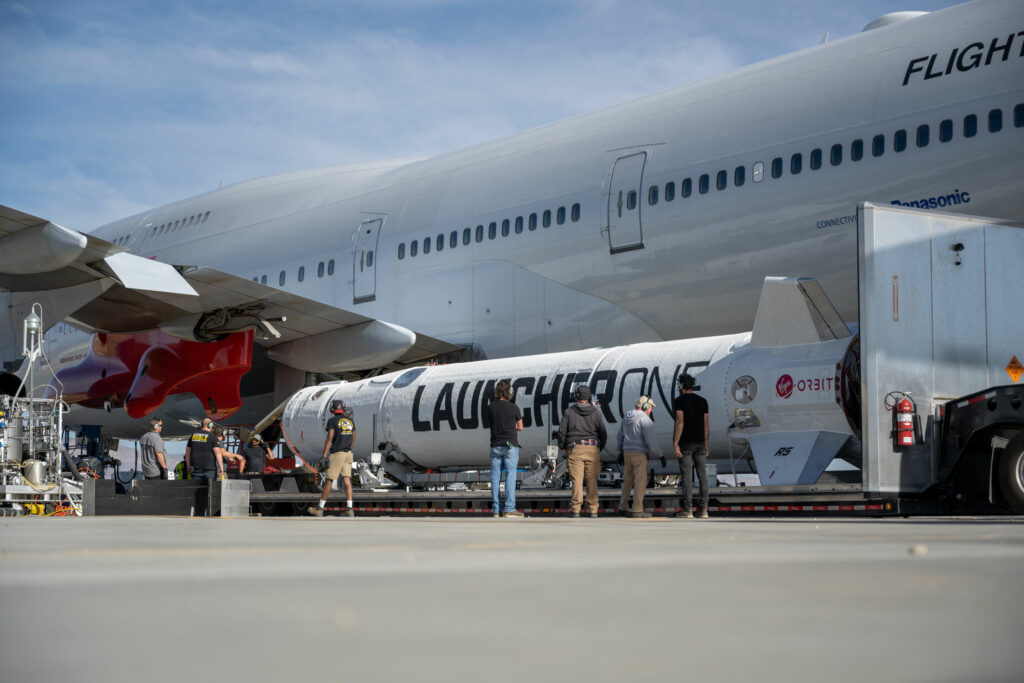
On January 13 at 22:53 UTC, a Virgin Orbit Launcher One launched the “Above The Clouds” mission from the Pacific Ocean off the coast of California.
The Cosmic Girl 747, which serves as the Launcher One’s flying launchpad, took off from the Mojave Spaceport in California an hour before launch flying over Los Angeles and then out over the Pacific Ocean. After the rocket was dropped from the plane, it successfully ignited its first-stage engine and climbed into orbit. Staging and all other flight events were nominal, and the seven payloads were successfully deployed into orbit an hour after launch.
The main customer for the third Launcher One commercial flight was the U.S. Department of Defense and NASA, which have four CubeSats on the flight. Also on the rocket were three commercial CubeSats.
One of them, the ADLER-1 CubeSat, is notable not because of what it does (though what it does is pretty cool – it involves radar) but because of how it got onto the rocket. It was added to the mission late in December 2021 after twenty days of discussion. Thirty-six hours after the payload was selected for this mission, it was integrated onto the rocket, which almost never happens. Usually, it takes weeks to get a payload on a rocket.
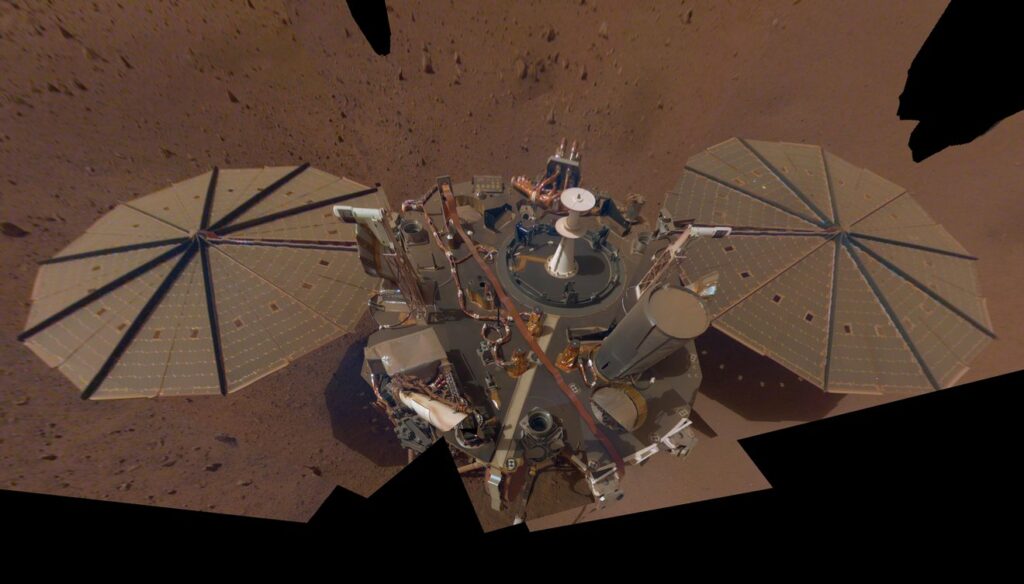
Next, we’ll talk about a mission that launched years ago and has been performing lots of science on Mars.
Let’s take a moment to bring up the InSight lander on Mars. This little mission arrived at the red planet in 2018 on a two-year mission to measure marsquakes and to try and probe beneath the surface. While the sandy soil foiled the burrowing probe, the seismograph has been taking spectacular data, and its mission was extended to December 2022. Unfortunately, the mission has had to go into safe mode as a massive dust storm blocks the sunlight it needs to power its systems and stay warm. We here at the Daily Space hope the storm ends with a solar panel cleaning gust and the lander is able to return to work soon.
From planets close to home to worlds orbiting alien stars, we now turn to the planet WASP-103b. This Jupiter-massed world orbits its star once per Earth day and is so close to its star that it is inflated by heat, and the star even raises tides of gas the way our Moon raises tides of water. The overall effect is a world that is more oval than round.
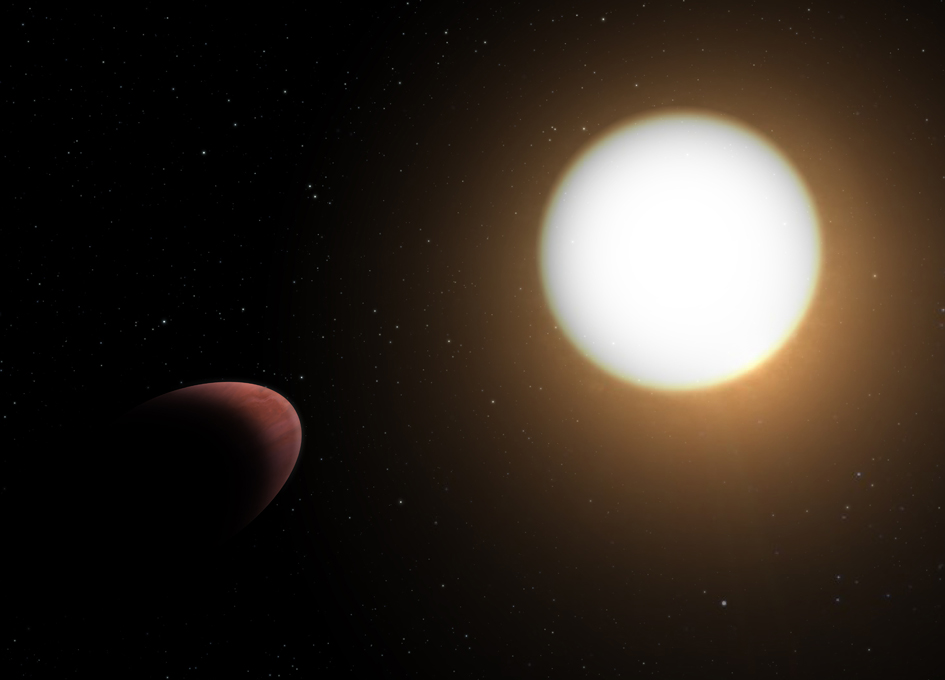
And we can see this weird shape in the data. As the planet passes in front of the star, we receive less and less light until the planet is completely in front of the star; we then get the same amount of less light until it begins to exit, and the light we receive increases again. The shape of this light curve can tell us a lot about the shape of the planet, and in this case, what we see is best explained by a planet distorted by tides.
From space, you can’t see the few feet the tides rise here on Earth, but if you could, you’d see the ocean rising up both on the side facing the Moon, where gravity is strongest, and on the opposite side, where gravity is least. In a lot of textbook examples, they’ll show the Earth distorted to look more like a rugby ball or less pointy football. This planet is that tidally distorted world made real.
Moral of the story? If you get too close to your star, you’ll get bloated up to 1.5 times your normal size and distorted into an oval.
This work appears in Astronomy & Astrophysics and was led by SCC Barros.
I love when scientists find stuff I never expected they’d find. While I might have imagined a tidally distorted oval of a planet, I have to admit I hadn’t imagined what is described in this next story.
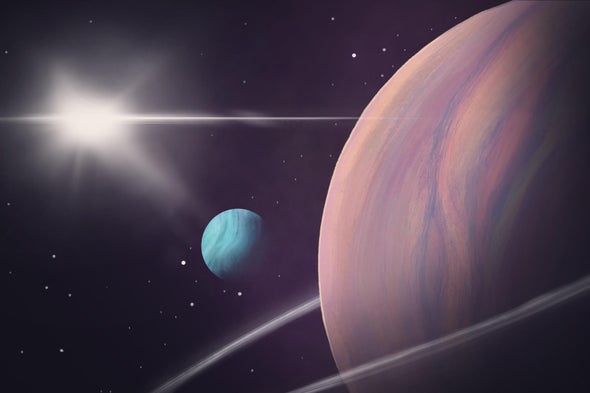
Researchers publishing in Nature Astronomy and led by David Kipping report that a roughly Neptune-sized moon may have been found orbiting a Jupiter-sized planet, both of which are going around a Sunlike star. Named Kepler-1708 b-i, this system periodically shows two dips in light when it passes in front of its star. The pattern of how the double dips appear (and don’t appear) over the past four years of observing are consistent with just one thing: a planet and a giant moon.
I have to admit, I now want to figure out if this is really more of a binary planet than a planet-moon situation, but that is maths for another day. What is key is that this system probably didn’t form like this. According to co-author Jessie Christiansen and reported in Scientific American: One scenario is this moon got captured by the planet as the planetary system was forming. Early planetary systems are quite violent, chaotic places. We see examples of capture in our own solar system: for instance, Triton, one of Neptune’s moons. We think that was captured. So we know that this can happen, we just hadn’t scaled it up to the idea that a Jupiter-sized planet could capture a Neptune-sized moon.
All these worlds with moons have one thing in common: they orbit stars with a large amount of heavy elements, relatively speaking, and those stars are going to one day add even more heavy elements to our universe that can get pulled into making future planets but maybe only to a point.

According to a new set of papers appearing in the Monthly Notices of the Royal Astronomical Society with lead authors Chiaki Kobayashi and Amanda Karakas, as stars are built out of more and more metal-rich material over time, they will eventually stop adding more heavy elements to space as they lock away more and more heavy elements in white dwarfs and other stellar remnants. This means, if this model is right, we could have a peak amount of heavy elements that we can’t get past.
This is just a computer model, but it is a neat one to think about and is the perfect fodder for some long thinking sci-fi author.
Now, to bring things back home a bit, and consider what we can see in the sky as opposed to in our simulations.
What’s Up
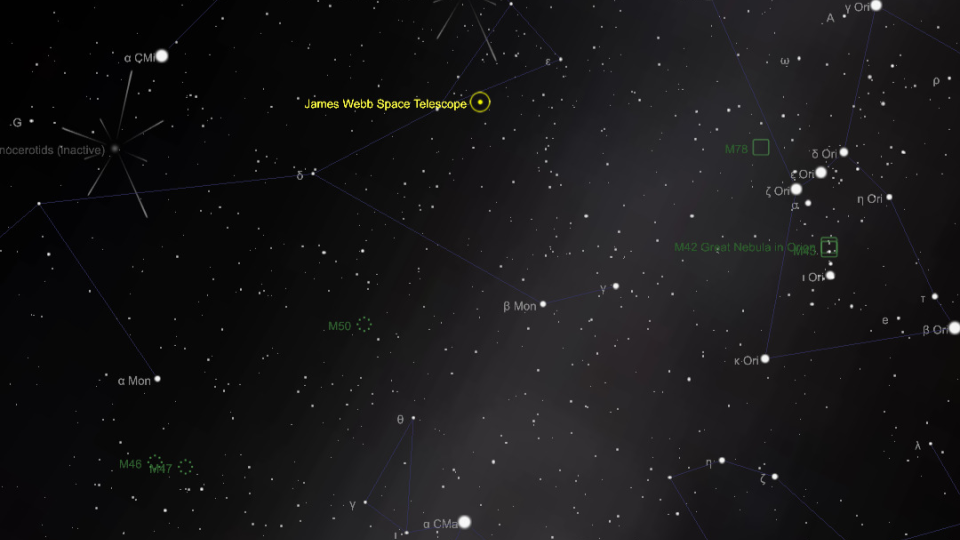
This week in What’s Up is not an impressive deep sky object or beautiful planet but something that humanity sent into space – the JWST.
It’s not often that you can see a human-made object in space at the eyepiece. The International Space Station can be seen with the unaided eye as it orbits very close to Earth, about 400 kilometers, and is the size of a football field. Thus, it is one of the brightest objects in the night sky after the Moon.
It’s even rarer still to be able to see a human-made object beyond low Earth orbit, as spacecraft are usually small and don’t reflect a lot of light.
The JWST is different, however, as a key part of its design is to reflect a lot of light, and therefore thermal energy, away from the telescope to keep it cool. This makes it very bright and possible to see, even at 1.2 million kilometers from Earth.
Another exception is rocket stages in low or medium orbit while firing their engines or venting after a mission, as the plumes of gas can be illuminated by the Sun and be seen with the unaided eye.
Since its launch back on Christmas Day 2021, the long-delayed telescope has completed almost all of its critical deployments, including its five-layer sunshield which passively lowers the telescope’s temperature from a blistering 55˚ Celsius to (as of January 13) an incredibly low -200˚ Celcius, just a few dozen degrees above absolute zero, the coldest anything can get. It will need to get a few degrees cooler still before beginning observations. It needs the sunshield to keep its instruments cool without needing a complicated liquid helium cryocooler, though it does have one of those as well. Its mid-infrared instrument needs it to reach -267˚C, just six degrees above absolute zero, to function best.
The sunshield has hundreds of square meters of shiny silver Kapton insulation, and this makes the sun-facing side of the spacecraft quite bright – bright enough that you should be able to see it at the eyepiece of a telescope. According to one source, it will be roughly magnitude +16, which is within the range of small observatories and large amateur telescopes such as a 10-inch or larger Dobsonian.
The JWST is nicely placed in the Northern Hemisphere night sky as it heads out to its ultimate destination at Earth-Sun Lagrange 2, a million and a half kilometers away from Earth. Currently, it is in between the constellations of Orion and Canis Major. It reaches its highest point in the sky around midnight Central time every night between now and the end of January.
To find it, look at the triangle formed by the bright stars Sirius, Betelgeuse, and Alhena. The JWST is between Betelgeuse and Sirius, closer to Betelgeuse. It’s due south of Alhena, just lower than the line between Sirius and Betelgeuse.
Many GoTo telescopes, which use a computer and electric motors to point the telescope at an object automatically, allow the user to input celestial coordinates of right ascension and declination of an object not in its database for the telescope to find. At 05:00 UTC on January 14, the JWST will be at 6 hours 39 minutes 33.5 seconds right ascension and 2 degrees 41 minutes 4.8 seconds declination. We will have an interactive finding chart available in the show notes for this episode so you can determine a more precise area in the sky for your observing location.
Remember, go outside and look up.
This Week in Rocket History
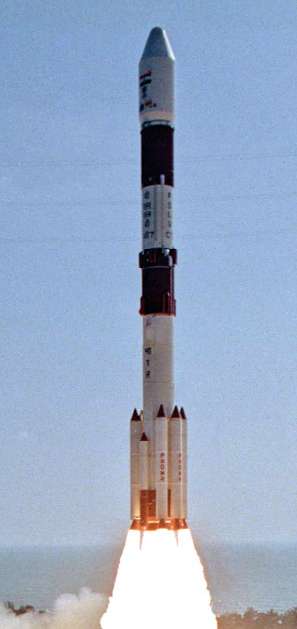
This week in rocket history is the SRE-1 capsule launch by ISRO.
In the first decade of this century, India’s space agency, ISRO, began its own human spaceflight program. This would not be the first time an Indian citizen went into space, as Rakesh Sharma had gone up for seven days in 1984 on the Soyuz T-11 mission to Salyut 7. In addition, several NASA astronauts were either born in India and moved to the U.S. or were born in the U.S. to Indian parents.
The first hardware demonstration of technology necessary for sending humans to space was the SRE, or Space capsule Recovery Experiment. The purpose of the SRE was to demonstrate the future capsule’s thermal protection system (TPS), guidance during reentry, and recovery operations. All of these operations are critical to recovering crewed capsules from space. The TPS was designed to be reusable with both silica tiles and phenolic ablators. While in space, the capsule would conduct experiments in microgravity.
By 2007, the SRE was ready. The 555-kilogram capsule was 1.6 meters tall and two meters wide, in the shape of a cone, like many reentry bodies. The flat end had solar panels and maneuvering rockets; it reentered pointy end first. It was launched into orbit on January 10, 2007, atop the PSLV C7 mission, the tenth overall flight of the PSLV rocket. It was launched in a dual launch configuration with Cartosat-2 and two other CubeSats riding above the SRE into a 625-kilometer sun-synchronous orbit. This was the first dual launch configuration of the PSLV, one it has used many times in the years since.
The two experiments on SRE-1 included a Biomimetic Material Processing Reactor. As the name sounds, biomimetics is the manufacture of materials similar to how they are made biologically. Specifically, the SRE-1 experiment synthesized self-assembling hydroxyapatite, a mineral very close to what makes up the human bone. This mineral is very useful for tissue engineering.
The other experiment was the Isothermal Heating Furnace which grew a gallium-magnesium-zinc quasicrystal in microgravity. Crystals grown in microgravity are often larger and more well-ordered than Earth-grown crystals.

The capsule did all of this running on about the same power as a Playstation 4, provided by fixed solar panels on the bottom of the capsule.
For twelve days the SRE orbited the Earth before reorienting and performing a ten-minute deorbit burn. It re-entered the Earth’s atmosphere successfully at 03:37 UTC on Jan 22, 2007, at a velocity of 8 km/s. Aerodynamic braking with the heat shield reduced that to just over 100 m/s, and deployment of the drogue chute reduced this further to 47 m/s. The main chutes brought it down to 12 m/s for a safe splashdown in the Bay of Bengal at 03:46 UTC. Another part of the SRE demonstration was a flotation system on the capsule, which was successfully deployed, righting the capsule. It was recovered by the Indian Navy and Coast Guard supported by aircraft.
With the SRE-1, India joined the exclusive group of nations that have both launched and recovered something from orbit. A follow-on mission was planned for 2009 to start a series of low-cost recoverable capsules for microgravity research; however, after a long series of delays, it was finally canceled in 2018 but not until after a lot of hardware had been constructed.
Statistics
To wrap things up, here’s a running tally of a few spaceflight statistics for the current year:
Toilets currently in space: 8: 4 installed on ISS, 1 on the Crew Dragon, 1 on the Soyuz, 1 on the Shenzhou, and 1 on Tianhe
Total 2022 orbital launch attempts: 3, with no failures
Total satellites from launches: 161
We keep track of orbital launches by where they launched from, also known as spaceport. Here’s that breakdown:
USA 3
This has been the Daily Space.
You can find more information on all our stories, including images, at DailySpace.org. As always, we’re here thanks to the donations of people like you. If you like our content, please consider joining our Patreon at Patreon.com/CosmoQuestX.
Credits
Written by Pamela Gay and Erik Madaus
Hosted by Pamela Gay and Erik Maduas
Audio and Video Editing by Ally Pelphrey
Content Editing by Beth Johnson
Intro and Outro music by Kevin MacLeod, https://incompetech.com/music/


 We record most shows live, on Twitch. Follow us today to get alerts when we go live.
We record most shows live, on Twitch. Follow us today to get alerts when we go live.